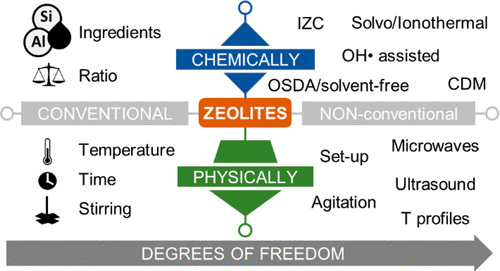当前位置:
X-MOL 学术
›
Chem. Mater.
›
论文详情
Our official English website, www.x-mol.net, welcomes your
feedback! (Note: you will need to create a separate account there.)
Zeolite Synthesis under Nonconventional Conditions: Reagents, Reactors, and Modi Operandi
Chemistry of Materials ( IF 7.2 ) Pub Date : 2020-04-30 , DOI: 10.1021/acs.chemmater.9b04741 Aron Deneyer 1 , Quanli Ke 1 , Julien Devos 1 , Michiel Dusselier 1
Chemistry of Materials ( IF 7.2 ) Pub Date : 2020-04-30 , DOI: 10.1021/acs.chemmater.9b04741 Aron Deneyer 1 , Quanli Ke 1 , Julien Devos 1 , Michiel Dusselier 1
Affiliation

|
A myriad of tetrahedral molecular sieve frameworks, often siliceous, can be calculated in silico. Only a tiny fraction (<0.1%) of these can be synthesized on purpose. Only a small fraction of these available frameworks, mostly those composed of only Si and Al as T atoms, i.e., true zeolites, are used commercially. A gap thus exists between what should be possible (thermodynamically) and what can be produced (kinetically) and used in real life. Even if a synthesis is successful (in industry or academia), flexibility with regard to synthesis parameters—in terms of time, amount of unit operations, OSDA efficiency, etc.—as well as the obtained material properties—in terms of Si/Al ratio, Al distribution, T atom variety, crystal size, etc.—remains limited. These limitations are not surprising, since conventional zeolite syntheses, i.e., hydrothermal synthesis in batch from amorphous or soluble Si and Al sources, have limited degrees of freedom (DOFs). Typically, the type of ingredients, their ratios, a constant temperature, the synthesis time, and the absence or presence of agitation are varied. In order to take new steps toward more cost-competitive syntheses, and more importantly zeolites with a greater flexibility in terms of structural properties, this Review highlights all DOFs that can be introduced in addition to or on top of the conventional way of synthesis. By doing this, a distinction is made between nonconventional DOFs that influence the chemistry of the system (e.g., interzeolite conversion, charge density mismatch, ionothermal or free-radical assisted synthesis) and nonconventional DOFs that influence the physical environment (e.g., ultrasounds, alternative energy via microwaves, or continuous setups). The Review concludes with learnings, practical insights, and future opportunities. In other words, which zeolite synthesis strategies really make a difference and which ones are just tweaking around the edges?
中文翻译:

非常规条件下的沸石合成:试剂,反应器和莫迪操作数
可以通过计算机计算无数的通常为硅质的四面体分子筛框架。这些中只有极小部分(<0.1%)可以有意合成。这些可用的骨架中只有一小部分,大部分是仅由Si和Al作为T原子组成的骨架,即真正的沸石,在商业上得到了使用。因此,在现实生活中应该可能发生的事情(热力学上)与可以发生什么事情(动力学上)之间存在差距。即使合成成功(在工业界或学术界),合成参数(如时间,单位操作量,OSDA效率等)以及所获得的材料特性(如Si / Al)的灵活性比率,Al分布,T原子种类,晶体尺寸等-仍然有限。这些局限性不足为奇,因为常规的沸石合成方法,即从无定形或可溶性Si和Al来源分批进行水热合成,具有有限的自由度(DOF)。通常,成分的类型,它们的比例,恒定的温度,合成时间以及是否存在搅拌是变化的。为了朝着更具成本竞争力的合成,以及更重要的是在结构特性方面具有更大灵活性的沸石采取新的步骤,本评论重点介绍了可在常规合成方法之外或之上引入的所有DOF。通过这样做,区分了影响系统化学性质的非常规自由度(例如,沸石间转化,电荷密度失配,电热或自由基辅助合成)和影响物理环境的非常规自由度(例如,超声,替代通过微波或连续设置获得能量)。总结以学习为结尾 实际见解和未来机会。换句话说,哪种沸石合成策略真正起作用,哪些只是在边缘调整?
更新日期:2020-06-23
中文翻译:

非常规条件下的沸石合成:试剂,反应器和莫迪操作数
可以通过计算机计算无数的通常为硅质的四面体分子筛框架。这些中只有极小部分(<0.1%)可以有意合成。这些可用的骨架中只有一小部分,大部分是仅由Si和Al作为T原子组成的骨架,即真正的沸石,在商业上得到了使用。因此,在现实生活中应该可能发生的事情(热力学上)与可以发生什么事情(动力学上)之间存在差距。即使合成成功(在工业界或学术界),合成参数(如时间,单位操作量,OSDA效率等)以及所获得的材料特性(如Si / Al)的灵活性比率,Al分布,T原子种类,晶体尺寸等-仍然有限。这些局限性不足为奇,因为常规的沸石合成方法,即从无定形或可溶性Si和Al来源分批进行水热合成,具有有限的自由度(DOF)。通常,成分的类型,它们的比例,恒定的温度,合成时间以及是否存在搅拌是变化的。为了朝着更具成本竞争力的合成,以及更重要的是在结构特性方面具有更大灵活性的沸石采取新的步骤,本评论重点介绍了可在常规合成方法之外或之上引入的所有DOF。通过这样做,区分了影响系统化学性质的非常规自由度(例如,沸石间转化,电荷密度失配,电热或自由基辅助合成)和影响物理环境的非常规自由度(例如,超声,替代通过微波或连续设置获得能量)。总结以学习为结尾 实际见解和未来机会。换句话说,哪种沸石合成策略真正起作用,哪些只是在边缘调整?









































 京公网安备 11010802027423号
京公网安备 11010802027423号